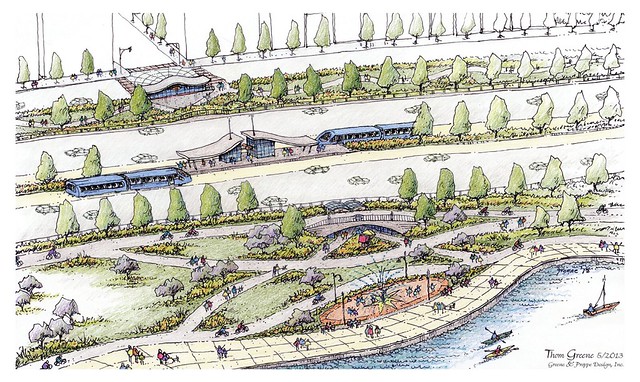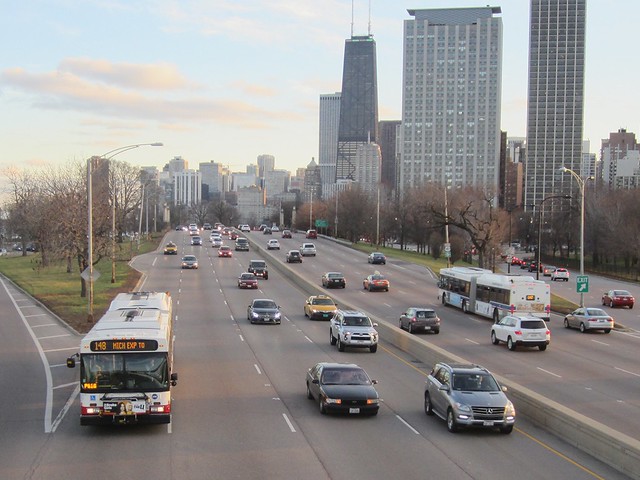[The Chicago Reader recently launched a new weekly transportation column written by Streetsblog Chicago editor John Greenfield. This partnership will allow Streetsblog to extend the reach of our livable streets advocacy. We’ll be syndicating a portion of the column on the day it comes out online; you can read the remainder on the Reader’s website or in print. The paper hits the streets on Thursdays.]
Earlier this month at a hearing on the North Lake Shore Drive reconstruction study—dubbed "Redefine the Drive"—officials assured the public that all options for rebuilding Chicago's coastal highway are still on the table. But the Illinois Department of Transportation, which has jurisdiction over the drive, isn't seriously considering the simplest way to help more people travel more efficiently: trading existing mixed-traffic lanes for bus-only lanes.
Immortalized in the eponymous song by local rock group Aliotta-Haynes-Jeremiah (R.I.P. bassist Mitch Aliotta, who passed away in July), the northern portion of Lake Shore Drive is 60 to 80 years old, and way overdue for a rehab. IDOT and the Chicago Department of Transportation are collaborating on the plan to rebuild the seven-mile section between Grand and Hollywood.
They expect to get approval for the design from the feds by 2018, with construction starting as early as 2019, pending available funding. The project could cost more than $1 billion and will take years to finish.
Starting in July 2013, the city and state transportation departments hosted a series of community meetings, where residents shared their ideas for the overhaul. In October 2014, the planners released a list of the 20 most popular ideas for the rehab, based on more than 1,600 comments from 330-plus attendees. "Improve transit service" came in second, after "Separate bike/pedestrian users on the Lakefront Trail." Maintaining or improving driving conditions didn't make the list.

During the recent hearing at the Chicago History Museum, planners from IDOT noted that North Lake Shore Drive sees 70,000 transit trips a day on nine routes, accounting for one-fifth of all passenger trips on the drive.
IDOT projects that the population of the study area, bounded by Touhy, the Kennedy/Dan Ryan, and the Stevenson, will grow 15 to 20 percent by 2040, based on a state analysis of Chicago Metropolitan Agency for Planning data. The department predicts the number of transit trips on the drive will increase by the same amount during this period. However, they project the increase in car trips will be negligible, because new Chicagoans will mostly commute by transit, and some current residents will switch from cars to other modes.
To meet the growing demand for transit, the LSD project team is considering options for the drive like bus-on-shoulder (which already exists on some Pace lines) and bus-only lanes, possibly with rapid transit-style stations along the route. Light rail is even in the mix, although it would likely be cost-prohibitive.
Liberating transit riders from car-generated congestion via dedicated lanes is a no-brainer, since buses are exponentially more space-efficient than automobiles. The planners said cars on the drive carry an average of 1.2 people. Meanwhile, a 60-foot articulated CTA bus seats about 50 people (not counting standees) and takes up less room on the highway than two average-size cars, when you factor in the necessary distances between vehicles.
During the hearing, planners stressed they haven't yet ruled out any options for reconfiguring the drive. But afterward, IDOT project and environmental studies section chief John Baczek told a different story to Charles Papanek, who reported on the meeting for Streetsblog .
Baczek said it's unlikely any of the drive's existing travel lanes will be converted to transit-only use, because this would reduce capacity for drivers, and the number of car trips isn't expected to decrease. Therefore, he implied, adding dedicated bus lanes would probably require widening the highway.




